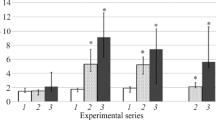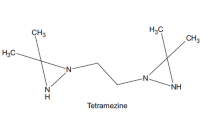Summary
The plasma binding of prednisolone was studied in twenty normal volunteers and twenty rheumatoid arthritis patients. An in vitro assessment of the binding following the addition of prednisolone, prednisone, and hydrocortisone to the plasmas obtained from the subjects showed significant differences in the percentage of prednisolone bound. However, the differences observed were regarded as clinically insignificant. The plasma protein binding was determined by an in vitro equilibrium dialysis of the individual plasma samples at 37° C. Prednisolone levels on both sides of the dialysis membrane were determined using radioactivity and HPLC analytical methodologies. The percentages of prednisolone bound calculated from the analytical results of either the radiochemical or HPLC method were not significantly different. The change in the percentage of prednisolone bound to plasma proteins was studied as a function of the total prednisolone plasma concentration in a normal volunteer and in a systemic lupus erythematosis patient. As a result of prednisolone binding to both transcortin and albumin, the binding of prednisolone changes as a function of prednisolone concentration. The binding data were fitted using nonlinear least squares regression, and the affinity constants for the binding of prednisolone to transcortin and albumin were estimated.
Similar content being viewed by others
References
Powell, L. W., Axelson, E.: Corticosteroids in liver disease: Studies on the biological conversion of prednisone to prednisolone and plasma protein binding. Gut13, 690–696 (1972)
Jenkins, J. S., Sampson, P. A.: Conversion of cortisone to cortisol and prednisone to prednisolone. Br. Med. J.1967/II, 205–207
Gennaro, A. R., Guttman, D. E.: Complexation. In: Remington's Pharmaceutical Sciences, XV. Osol, A., Hoover, J. E., (eds.), pp. 206–210. Easton: Mack Publishing Co. 1975
Lewis, G. P., Jusko, W. J., Burke, C. W., Graves, L.: Prednisone side-effects and serum-protein levels. Lancet1971/II, 778–780
Jusko, W. J.: Pharmacokinetics in disease states changing protein binding. In: The Effect of Disease States on Drug Pharmacokinetics. Benet, L. Z. (ed.), pp. 99–123. Washington: American Pharmaceutical Association, Academy of Pharmaceutical Sciences 1976
Rocci, M. L., Jusko, W. J.: Animal model for dose dependent protein binding and disposition of prednisolone. In: Abstracts Papers. Vol. 8, p. 89. Washington: American Pharmaceutical Association, Academy of Pharmaceutical Sciences 1978
Westphal, U.: Corticosteroid-binding globulin and other stcroid-binding serum proteins. In: Methods in Enzymology, XV. Steroids and Terpenoids. R. B. Clayton (ed.), pp. 761–796. New York, London: Academic Press 1969
Westphal, U.: Steroid-protein interactions. XIII. Concentrations and binding affinities of corticosteroid-binding globulins in sera of man, monkey, rat, rabbit, and guinea pig. Arch. Biochem. Biophys.118, 556–567 (1967)
Angeli, A., Frajria, R., Depaoli, R., Fonzo, D., Ceresa, F.: Diurnal variations of prednisolone binding to serum corticosteroid-binding globulin in man. Clin. Pharmacol. Ther.23, 47–53 (1978)
Turner, A. K., Carroll, C. J., Pinkus, J. L., Charles, D., Chattoraj, S. C.: Simultaneous competitive protein binding assay for cortisol, cortisone, and prednisolone in plasma, and its clinical applications. Clin. Chem.19, 731–736 (1973)
Metzler, C. M.: A user's manual for NONLIN, technical report 7292/69/7292/005. The Upjohn Co., Nov. 25, 1969
Sullivan, T. J., Hallmark, M. R., Sakmar, E., Weidler, D. J., Earhart, R. H., Wagner, J. G.: Comparative bioavailability: Eight commercial prednisone tablets. J. Pharmacokinet. Biopharm.4, 157–172 (1976)
Chesrow, E. J., Bronsky, D., Orfei, E., Dyniewicz, H., Durbin, A., Musci, J.: Serum proteins in the aged. Geriatrics13, 20–24 (1958)
Levy, G.: Clinical pharmacokinetics of aspirin. Pediatrics62, 867–872 (1978)
Meloun, B., Moravek, L., Kostka, V.: Complete amino acid sequence of human serum albumin. FEBS Lett.58, 134–137 (1975)
Evans, P. H.: The effect of drugs on serum sulfhydryl levels in rheumatoid disease. Scand. J. Rheumatol.6, 69 (1977)
Reid, R. T., Farr, R. S.: Further evidence for albumin alterations in some patients with rheumatic disease. Arthritis Rheum.7, 747–748 (1964)
Hinchen, J. D.: Practical statistics for chemical research, p. 25. London: Methuen and Co. Ltd. 1969
Author information
Authors and Affiliations
Rights and permissions
About this article
Cite this article
Ağabeyoğlu, I.T., Bergstrom, R.F., Gillespie, W.R. et al. Plasma protein binding of prednisolone in normal volunteers and arthritic patients. Eur J Clin Pharmacol 16, 399–404 (1979). https://doi.org/10.1007/BF00568200
Received:
Revised:
Accepted:
Issue Date:
DOI: https://doi.org/10.1007/BF00568200




